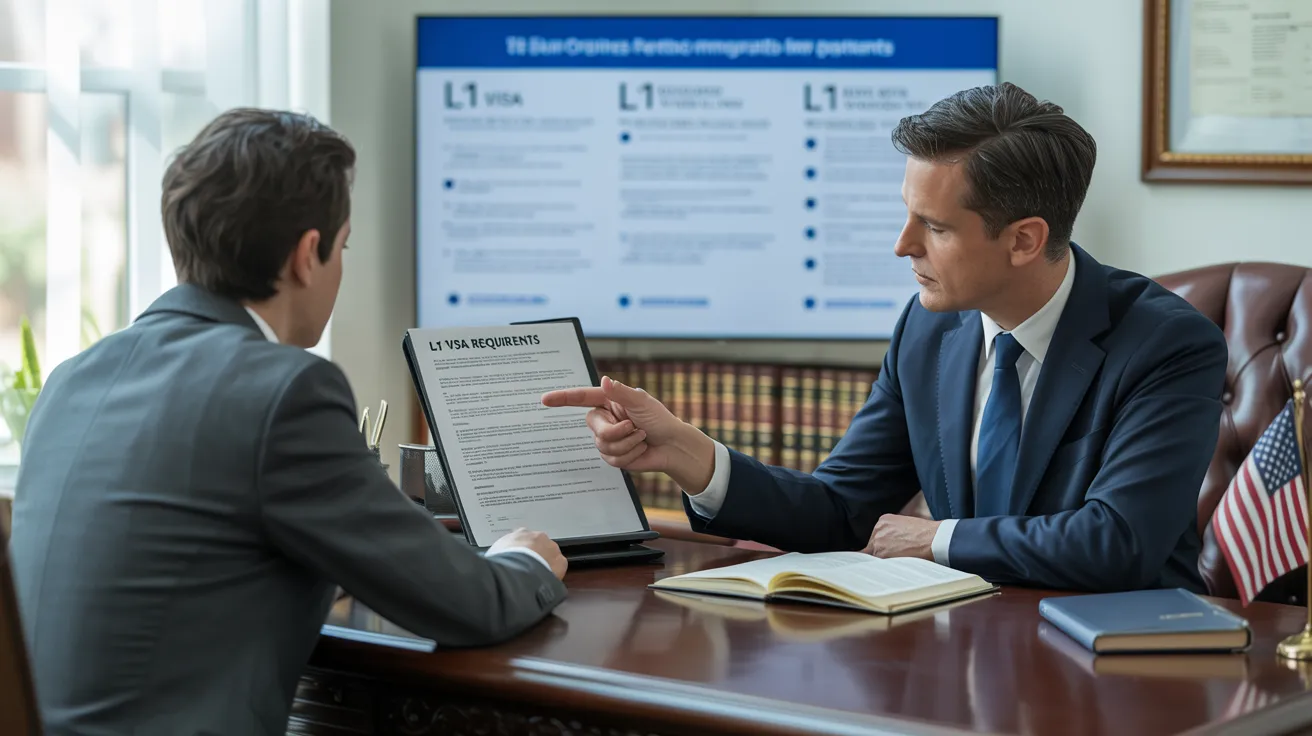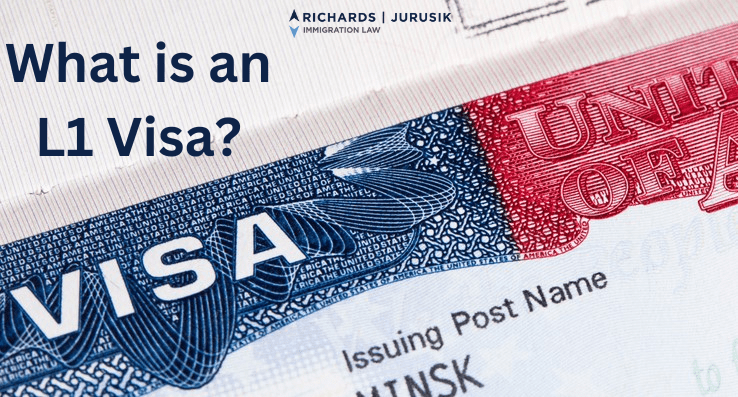Whatever You Need to Learn About the L1 Visa: Advantages, Needs, and Extra
The L1 Visa works as an essential tool for multinational business looking for to transfer staff members to the United States, promoting both operational efficiency and the transfer of specialized knowledge. With distinct classifications for execs and specialized professionals, this visa provides various advantages, including prospective pathways to permanent residency. Understanding the eligibility demands and application procedure is crucial for an effective change. As we examine the details of the L1 Visa, it becomes clear that navigating its intricacies is critical for organizations intending to utilize global skill successfully. What challenges might you encounter in the process?
Introduction of the L1 Visa

Types of L1 Visas

Multiple types of L1 visas accommodate the varied requirements of multinational companies seeking to move workers to the United States. Both main groups of L1 visas are L1A and L1B, each created for details duties and duties within an organization. L1 Visa Requirements.The L1A visa is intended for supervisors and executives. This category allows companies to move people that hold supervisory or executive placements, enabling them to manage procedures in the U.S. This visa is valid for a first duration of as much as 3 years, with the opportunity of extensions for an overall of as much as 7 years. The L1A visa is particularly advantageous for business seeking to develop a strong leadership existence in the U.S. market.On the other hand, the L1B visa is marked for workers with specialized understanding. This includes individuals that possess innovative proficiency in specific locations, such as exclusive modern technologies or one-of-a-kind processes within the firm. The L1B visa is additionally legitimate for a first three-year duration, with expansions readily available for as much as five years. This visa category is perfect for companies that require staff members with specialized skills to enhance their operations and maintain an one-upmanship in the U.S.Both L1A and L1B visas enable dual intent, indicating that visa holders can obtain irreversible residency while on the visa. Recognizing the differences in between these two groups is crucial for services preparing to browse the intricacies of worker transfers to the USA effectively
Qualification Demands
To get an L1 visa, both the company and the staff member have to satisfy particular qualification criteria set by united state migration authorities. The L1 visa is made for intra-company transferees, permitting international firms to transfer employees to their united state offices.First, the employer has to be a certifying company, which implies it has to have a parent company, branch, subsidiary, or associate that is operating both in the united state and in the international country. This partnership is essential for demonstrating that the worker is being transferred within the exact same company structure. The employer needs to also have been doing service for at least one year in both locations.Second, the staff member must have been utilized by the international company for at least one constant year within the three years preceding the application. This employment needs to remain in a managerial, exec, or specialized expertise capability. For L1A visas, which accommodate managers and executives, the employee must demonstrate that they will certainly proceed to operate in a similar capability in the united state For L1B visas, meant for workers with specialized understanding, the individual must have special expertise that contributes substantially to the firm's procedures.
Application Process
Maneuvering the application process for an L1 visa entails a number of important steps that have to be finished precisely to ensure a successful end result. The very first step is to identify the ideal classification of the L1 visa: L1A for managers and execs, or L1B for workers with specialized understanding. This distinction is significant, as it impacts the paperwork required.Once the group is identified, the united state employer need to submit Kind I-129, Application for a Nonimmigrant Employee. This type should include detailed details concerning the company, the employee's duty, and the nature of the work to be done in the U.S. Accompanying documents commonly includes proof of the connection in between the united state and international entities, proof of the worker's credentials, and details regarding the job offer.After entry, the U.S. Citizenship and Migration Services (USCIS) will assess the petition. If authorized, the worker will be notified, and they can then make an application for the visa at a united state consular office or consular office in their home country. This includes finishing Type DS-160, the Online Nonimmigrant copyright, and arranging an interview.During the interview, the candidate has to provide different documents, including the accepted Type I-129, evidence of employment, and any extra sustaining proof. Following the meeting, if the visa is given, the staff member will obtain a visa stamp in their ticket, permitting them to get in the U.S. to work for the funding employer. Appropriate prep work and detailed paperwork are vital to steering this process effectively.
Advantages of the L1 Visa
Among the significant advantages of the L1 visa is its capability to help with the transfer of key personnel from international offices to the USA. This visa is specifically helpful for international firms looking for to maintain uniformity in procedures and leadership across boundaries. By permitting execs, supervisors, and specialized employees to operate in L1 Visa requirements the U.S., companies can ensure that their most necessary talent is available to drive service objectives.Another considerable benefit of the L1 visa is its reasonably straightforward application procedure contrasted to other work visas. Organizations can request for the L1 visa without the need for a labor certification, which enhances the recruitment of foreign employees. The visa can be approved for a first duration of up to 3 years, with the possibility of extensions, promoting long-term assignments.The L1 visa additionally gives a course to long-term residency. Employees on L1A visas (for managers and execs) can look for a Permit after one year, accelerating their adjustment to irreversible status. This function is an appealing reward for talented individuals seeking stability in the U.S. workforce.Additionally, L1 visa owners can bring their immediate relative to the U.S. under L2 status, enabling partners and youngsters to live and examine in the nation, improving the total allure of this visa category. On the whole, the L1 visa works as a crucial tool for international services, cultivating cross-border collaboration and skill mobility.
Usual Obstacles
While the L1 visa offers countless advantages for multinational business and their workers, it is not without its obstacles. One notable obstacle is the rigid documents and qualification needs imposed by the U.S. Citizenship and Immigration Services (USCIS) Firms must provide in-depth evidence of the international staff member's credentials, the nature of business, and the qualifying relationship in between the united state and foreign entities. This procedure can be lengthy and may require legal competence to browse successfully.Another difficulty is the possibility for analysis during the application procedure. USCIS police officers might examine the authenticity of the company procedures or the worker's role within the organization. This analysis can bring about delays or perhaps rejections of the copyright, which can significantly affect the firm's operational plans and the worker's profession trajectory.Furthermore, the L1 visa is connected to the funding company, which indicates that work changes can make complex the visa status. If an L1 visa owner desires to switch over employers, they need to often pursue a different visa group, which can include intricacy to their immigration journey.Lastly, preserving conformity with L1 visa policies is important. Companies have to ensure that their staff member's duty straightens with the first application and that business remains to fulfill the qualification needs. Failure to do so can cause abrogation of the visa, impacting both the staff member and the organization. These challenges demand thorough preparation and ongoing administration to ensure a successful L1 visa experience.
Tips for Success
To successfully navigate the L1 visa process, precise preparation is important. Beginning by thoroughly comprehending the particular demands for the L1 visa category you are requesting, whether L1A for supervisors and execs or L1B for staff members with specialized knowledge. Collect all needed documents early at the same time, including proof of your employment background, business structure, and the nature of business operations.Engage lawful guidance experienced in migration legislation to guide you through the intricacies of the application. An attorney can assist guarantee that your application is full, accurate, and engaging. They can also help in planning for possible ask for evidence (RFEs) by proactively addressing areas that might elevate questions.Additionally, preserve clear communication with your company, who need to supply essential assistance for your application. L1 Visa. Validate that they comprehend their responsibilities, including filing the necessary petitions and giving documents that substantiates your role in the organization.Prepare for the visa meeting by practicing solutions to typical inquiries concerning your professional background and the nature of your employment. Showing self-confidence and clarity can substantially influence the outcome of your application
Regularly Asked Questions
Can Family Members Accompany L1 Visa Owners?
Yes, household members can accompany L1 visa holders. Spouses and unmarried children under 21 years old are eligible for L2 visas, which enable them to live and research in the USA throughout the L1 owner's stay.
How Long Can L1 Visa Owners Stay in the U.S.?
L1 visa owners can initially remain in the united state for as much as three years (L1 Visa Requirements). This period might be extended, enabling a maximum stay of 7 years for L1A visa owners and 5 years for L1B visa owners
Is the L1 Visa a Dual Intent Visa?

Can L1 Visa Holders Make An Application For an Environment-friendly Card?
Yes, L1 visa owners can make an application for a permit - What Is L1 Visa. The L1 visa supports double intent, allowing holders to pursue irreversible residency while preserving their non-immigrant status, facilitating a smoother transition to an eco-friendly card
What Occurs if an L1 copyright Is Rejected?
If an L1 copyright is rejected, the applicant might receive a notification outlining the reasons for rejection. L1 Visa. They can appeal the decision, reapply, or explore different visa choices relying on their scenarios and certifications
Conclusion
In recap, the L1 Visa works as a necessary tool for multinational business seeking to move staff members to the USA. Understanding the distinctions in between L1A and L1B categories, together with the qualification needs and application procedures, is vital for effective navigation of this non-immigrant category. The benefits supplied, consisting of streamlined applications and pathways to irreversible residency, better enhance its charm. Dealing with typical difficulties efficiently can bring about a more favorable end result in the copyright procedure.
Comments on “L1 Visa Attorney Support”